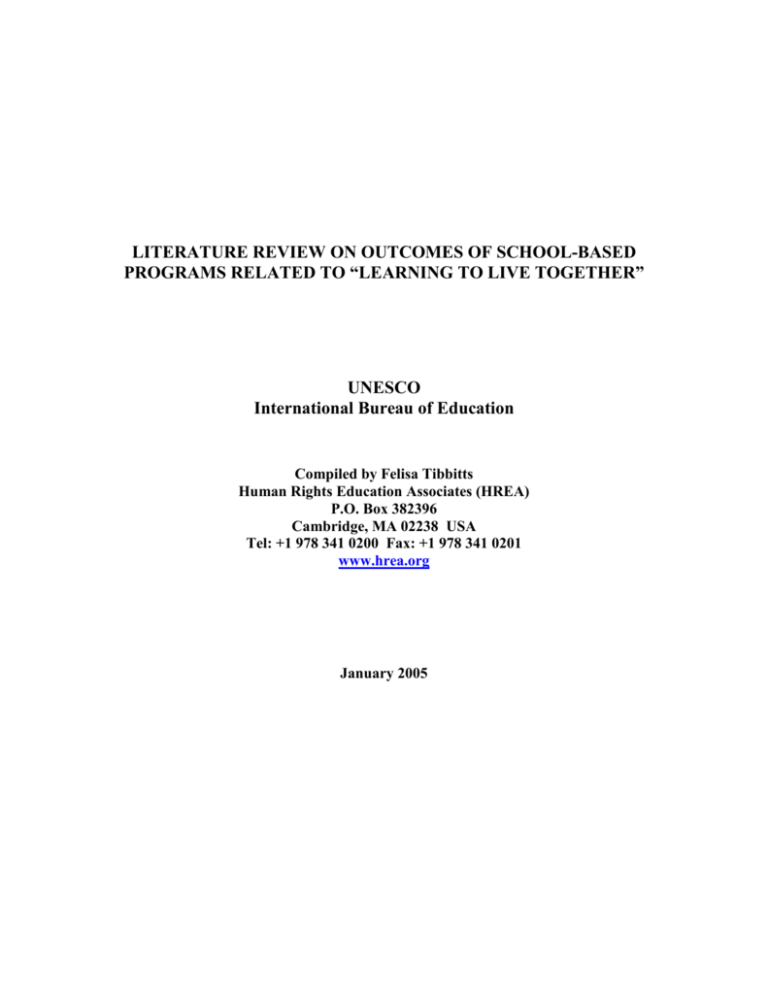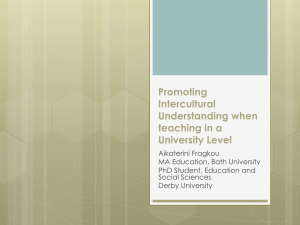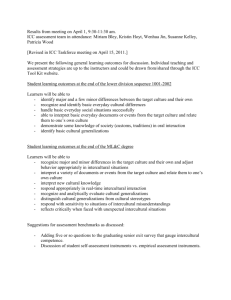LITERATURE REVIEW ON OUTCOMES OF SCHOOL
advertisement

LITERATURE REVIEW ON OUTCOMES OF SCHOOL-BASED PROGRAMS RELATED TO “LEARNING TO LIVE TOGETHER” UNESCO International Bureau of Education Compiled by Felisa Tibbitts Human Rights Education Associates (HREA) P.O. Box 382396 Cambridge, MA 02238 USA Tel: +1 978 341 0200 Fax: +1 978 341 0201 www.hrea.org January 2005 IV. SUMMARY OF RESEARCH FINDINGS ON CHARACTERISTICS OF SUCCESSFUL PROGRAMS The following is an excerpt from the full report, which can be found on the UNESCO website and on HREA’s website in the Research area of the library: http://www.hrea.org/erc/Library/ The characteristics of successful programs can, to a certain extent, be extrapolated from the research already presented. Individual studies have also focused on programming elements such as course design and the quality of instruction. One comparative study found that civic education programs in South Africa, Poland and the Dominican Republic were most effective when: - Sessions are frequent. There appears to be a “threshold effect” in terms of number of courses, where one or two sessions have little to no impact, but, when the number increases to three or more, there is the prospect for significant changes. - Methods are participatory. Breakout groups, dramatizations, role-plays, problem solving activities, simulations, and mock political or judicial activities led to far greater levels of positive change than did more passive teaching methods such as lectures or the distribution of materials. - Teachers are knowledgeable and inspiring. Not surprisingly, teachers who fail to engage their students have little success in transmitting information about democratic knowledge, values, or ways to participate effectively in the democratic political process.1 Researchers found similar results for anti-bias education efforts. In order to effectively address bias and prejudice and promote inter-group harmony among students, researchers have found that certain dynamics must be in place. Anti-bias efforts are most beneficial: - 1 when all students are involved when it is in-depth, long-term and infused into the overall curriculum when students are introduced to multicultural activities as young an age as possible Office of Democracy and Governance, Bureau for Democracy, Conflict and Humanitarian Assistance, Approach to Civic Education: Lessons Learned (Washington, DC: US Agency for International Development, June 2002), pp. 1-2, 29. Similar results were found in the study “Civic Education across Countries: Twenty-four National Case Studies from the IEA Civic Education Project.” There was unanimity among the authors of the national case studies that civic education should be based on important content that crosses disciplines, and that it should be “participative, interactive, related to life, conducted in a non-authoritarian environment, cognizant of the challenges of social diversity, and co-constructed with parents, the community, and non-governmental organizations, as well as the school” Judith Torney-Purta, John Schwille, and Jo-Ann Amadeo, The IEA Civic Education Study: Expectations and Achievements of Students in Thirty Countries (December 1999), ERIC Digest. - when teachers have the attitudes, training, materials and support needed to deliver the activities and lessons2 Research that can illuminate our understanding of the characteristics of successful “Learning to Live Together” programming can be divided into three general categories: methodology of teaching, the learning environment and teacher qualities. These are now presented in greater detail. Teaching methodology: Cooperating learning, group activities and participation A review of the research on the social and particularly the achievement effects of cooperative learning groups found that cooperative learning produced outcomes equal or superior to those of other learning structures. This was true regardless of race, sex, academic ability level, and other factors.3 This is a generalized finding. A U.S. national assessment of 4th and 8th grade civic education classrooms (1998) found that students’ participation in group activities and projects tended to outscore those who rarely or never participated in this kind of classroom assignment. 4 More specialized studies have not contradicted this finding. In Roma-integrated schools, more that ¾ of teachers considered that a range of socio-emotional improvements were stimulated by the different project-related activities: group work (34%), cooperative learning activities (24.5%), extra-school activities (reading clubs, exhibitions 23.4%), intercultural activities (10.6%) and other activities promoting Roma culture (9.6%). Positive effects generated by those activities were: “better understanding to each other, mutual acceptance,” “respect for cultural values,” “diminished prejudices and stereotypes.” At the same time, extra school activities “improve student-student, students-teacher and students-teachersparent relationships.”5 Cooperative learning is not merely a methodology for learning but a medium for promoting more general socio-emotional outcomes in children. Research also suggests that the same can be said for programs promoting “helping” behaviors and self-directed learning. The importance of the “helping” variable has been demonstrated in both family socialization studies (focusing on performance of household chores) and in some experimental research. Some of the pro-social development programs described include participation in helping activities in the classroom, school and wider community as an important element, but its most direct application has been in the form of community 2 (Campbell and Farrell 1985; Garcia, Powell and Sanchez 1990; King 1983; Merrick 1988; Rich 1990; Ruiz 1982; and Swadener 1986, 1988) as referenced in “The A World of Difference Institute Philosophical Framework”, Anti-Defamation League website, www.adl.org 3 R. E. Slavin, “Cooperative Learning and Student Achievement”, Chapter 5 in School and Classroom Organization, edited by R. E. Slavin, Hillsdale, NJ: Erlbaum, 1989. 4 John J. Patrick, The National Assessment of Educational Progress in Civics (March 2000), University of Indiana website. 5 Catalina Ulrich, et al (2002), pp. 24-5. service programs, which have shown some positive effects on interpersonal attitudes and beliefs and commitment to further helpful action.6 Programs and approaches that promote student autonomy and self-direction in learning have been positively associated with students’ sense of community, moral reasoning, democratic values, and positive interpersonal behavior. Although the relative contribution of this set of independent variables to the overall effects of the program cannot be determined, the apparent link has been shown in research relating to programs in progressive education, open education, constructivist classrooms, and cooperative learning, and in a number of specific programs (such as Just Community and CDP).7 The learning environment: Open and inclusive classroom climate The same educational approaches and programs that emphasize student autonomy typically also emphasize student interaction and discussion. Research on small groups has confirmed the importance of peer interaction for child development. Other approaches, such as moral dilemma discussion, focus on these interaction processes specifically and have shown small but consistent effects on moral reasoning. Thus, along with student autonomy-influence, student interaction and active participation in discussions has been shown to help bring about various outcomes in a broad range of studies.8 In a classroom setting, learning how to effectively manage conflict and engage in dialogue can also be a powerful instructional tool. When teachers welcome conflict and controversy they are affirming its naturalness, revealing its beneficial aspects, and taking away some of the negativity and ominousness that gets attached to it. When they structure conversations that allow students to express opinions, hear divergent perspectives, and respectfully consider alternative explanations, they are teaching basic skills in coping with conflict as well as a tolerance for diversity and a respect for democratic values. And when they facilitate real engagement in conflict, whether it is around issues of school life in a democratic classroom or just community, in classroom dialogue about moral and political perspectives, or in direct engagement in real political controversy, they are teaching students the skills they will need to effectively participate in our political process.9 Studies have shown that teachers working in culturally diverse classrooms can foster respect and inclusiveness by actively responding to intercultural tension and involving students in multi-cultural and inter-cultural activities. Successful teachers take issue with 6 Solomon et al (2001), p. 593. Ibid. In addition, in three international studies, students’ level of political tolerance has been associated with their perception of an open classroom climate, one in which they feel free and secure to express their ideas and opinions (Hahn, 1998; Nielson 1997; Turney-Purta, Lehmann, Oswald & Schwartz, 2001) as referenced in Avery (2001). 8 Solomon et al (2001), p. 593. 9 Berman (1997), pp. 122-3. 7 cultural demeaning statements, jokes, and graffiti, and use racial or other intercultural incidents as a springboard for providing information and skills to avoid such incidents.10 Teachers can promote a tone and climate in the classroom environment that promotes positive inter-cultural relations, in addition to socio-emotional learning in students more generally. Teachers in inter-culturally harmonious environments arrange their classrooms for movement and active learning; interact one-on-one with each child at least once a day; communicate high expectations for the performance of all students; give praise and encouragement; communicate affection for and closeness with students through verbal and nonverbal means; give children responsibility for taking care of things in the classroom; and treat all students equally and fairly.11 Teacher quality: Teacher preparation and motivation Although it may seem self evident, it worth mentioning directly that a curriculum is only as powerful as the teacher using it. Put another way, a well designed learning program in the hands of a well trained, skilled and motivated educator is much more likely to achieve its stated goals than a curriculum implemented under any variation of the above. Existing research indicates that the effective implementation of new curricula depends on several variables including teachers’ agreement with the goals of a new program, its impact on workload, and opportunities for professional development. The purpose of one study in a human rights education classroom was to assess how far 31 grade 8 teachers implemented a new children’s rights curriculum, whether the implementation changed their and their students’ attitudes about children’s rights, and to identify factors that encouraged implementation. Major findings were as follows: Workload, defined in terms of years of experience and class size, was predictive of curriculum use.12 Specifically, the greater the years of experience and the smaller the class size, the more likely it was that the curriculum was used. If workload is the major predictive of how likely a teacher is to try a new curriculum, outlook is close behind. A Finnish study presented the results and activity ideas created by a peace and international education project. The project found that teachers needed to have a positive attitude towards new ideas in order to create a new model of teaching. Problems of implementation were alleviated somewhat by keeping all the staff and parents informed of all the new activities.13 10 Aviram,1987; Campbell and Farrell 1985; Garcia, Powell and Sanchez 1990; King 1983; Mock 1988; Roberts 1982; Sanders and Wiseman 1990; Simpson 1981; and Swadener 1988, as quoted in Cotton (no date). 11 Ibid. 12 Katherine Covell, Johanna L. O’Leary, R. Brian Howe, “Introducing a New Grade 8 Curriculum in Children’s Rights” in Alberta Journal of Educational Research, Vol. 48 (4), Winter 2002, pp. 302-313. 13 Riitta Walstrom, “Growth towards Peace and Environmental Responsibility: From Theory to Practical Implications” (Jyvaskla, Finland: Institute for Educational Research, University of Jyvaskla, 1991). In some cases, the program itself will be instrumental in altering teacher perceptions and increasing their enthusiasm. This may be particularly the case for potentially sensitive subjects such as “anti-bias education” or in a situation where a new curriculum is mandated rather than voluntarily undertaken by educators. In Spain, a review was made of the multiculturalism educational programs and strategies developed in the country. Based on this review, a training course was developed for teachers in order to improve the attitudes of teachers and educators towards intercultural education and the growing cultural diversity in Spain. Initially the teachers in both groups (experimental and comparison) indicated that intercultural education in schools and teacher training were necessary in their opinion. However, they also indicated that the issue only concerned cultural minorities. It was seen as irrelevant to the pupils belonging to the cultural majority, nor did it have relevance for transformation of the school. However, following the participation in the training course, the attitudes of the teachers in the experimental groups improved significantly with respect to the objectives and their predisposition towards intercultural education programs. Both groups of teachers also had negative expectations of pupils from minority cultures. Teachers blamed such pupils for diminishing the quality of teaching in the classroom as well as creating disciplinary problems. They demonstrated very little intercultural sensitivity in their work; they exhibited a rejection of other cultural values and refused to question their own values. The experimental groups after the course, however, showed a marked attitudinal improvement in all the attitudinal nuclei: cultural diversity in teaching, intercultural sensitivity and multicultural coexistence.14 This aforementioned finding is closely linked with that of another – the habit of self examination and improvement among teachers. Effective teachers of culturally diverse classes reflect on their own values, stereotypes, and prejudices and how these might be affecting their interaction with children and parents.15 In addition to identifying various characteristics of successful programs, research has begun to answer the question of how to promote “learning to live together” through social integration at the school level. Genova and Wahlberg’s large scale correlation study on this topic identified the following characteristics of inclusive schools: 14 - Racial/ethnic mixing. While insufficient to guarantee positive outcomes, cultural mixing was found to be an important precondition for their development. - Positive staff role models. Visible and healthy interracial/ethnic relations prevailed. - Security. Students expressed feeling safe from the threat of intercultural conflict. Auxiliadora Sales Ciges & Rafaela Garcia Lopez, “Teacher Training with a View Towards Developing Favourable Attitudes Regarding Intercultural Education and Cultural Diversity” in European Journal of Intercultural Studies, Vol. 9, No. 1, 1998, pp. 72-74. 15 Op cit., Aviram, et al. - Staff support for integration. Beyond role modeling, this refers to openly expressed opinions in favor of integration. - Multicultural exposure. These minimally include activities that present students with a factual accounting of the contributions of various cultures. - Intercultural fairness. Students perceived that different racial/ethnic groups were treated equally and fairly by school personnel.16 - Contact with parents. Effective teachers engage parent involvement; demonstrate interest in and respect for the family’s culture when interacting with parents; find out as much as they can about each child’s experience and family situation that can help them to understand and meet the child’s needs.17 Child-friendly school system in Asia UNICEF has an initiative called child-friendly school system (CFSS) in Asia, which draws on many of the principles of good practice that have been documented. The CFSS initiative promotes a new appreciation of and approach to basic education in that the school, to become truly child-friendly, needs to be where students, teachers, parents and the community work together in support of children’s education and development. A checklist of traits for the child-friendly school program in the Philippines includes: - inclusive, gender-sensitive and non-discriminating caring and protective of all children is child-centered encourages children to think and decide for themselves, ask questions and express their opinions encourages children to participate in school and community activities encourages children to work together to solve problems and to achieve what they aim to do encourages children to express their feelings through art – music, drama and other forms. Source: HURIGHTS OSAKA, “The Practice Aspects of Learning Human Rights”, Part II, posted on hre-asiapacific@hrea.org listserv on 5 July 2004. 16 17 Ibid. Op cit., Aviram, et al.






